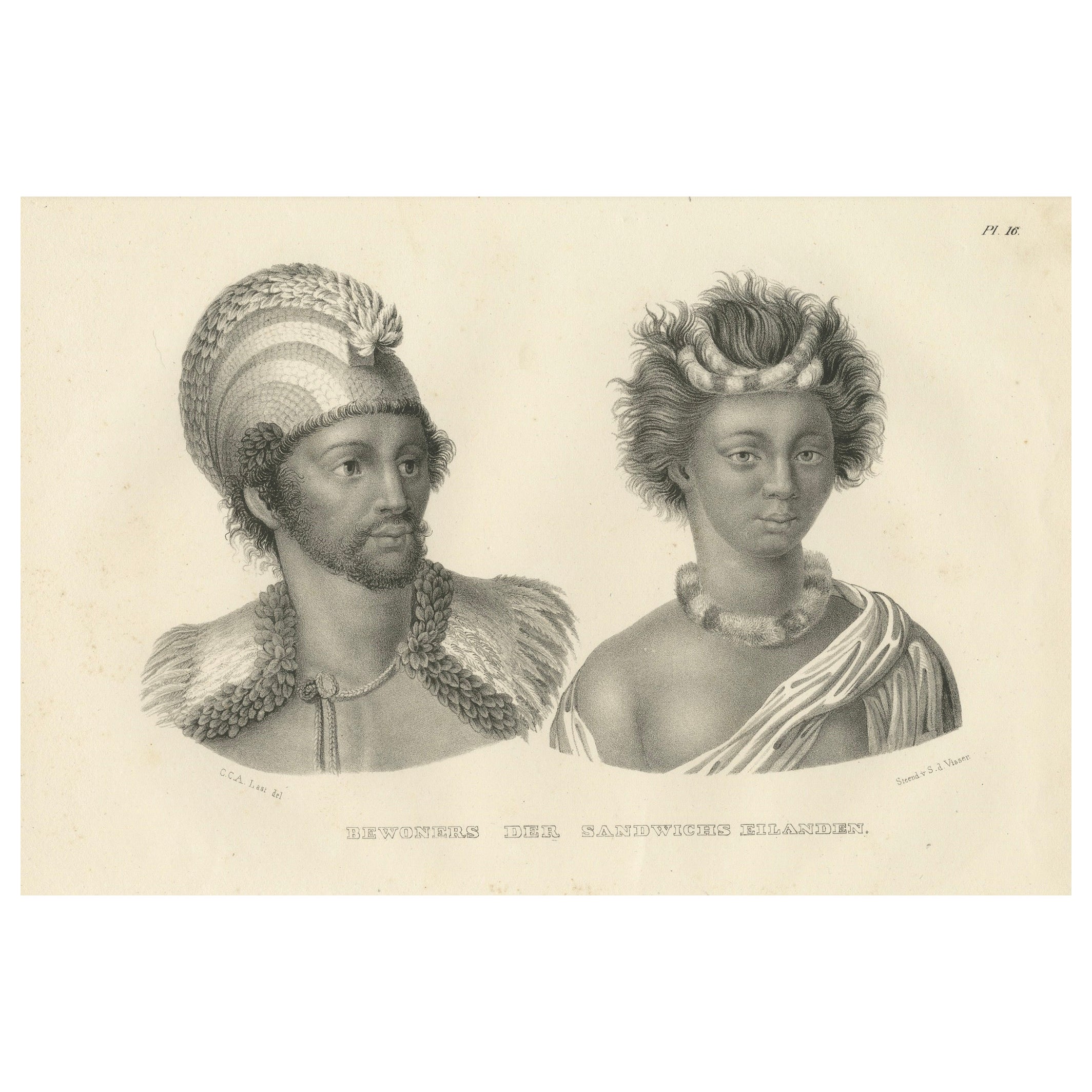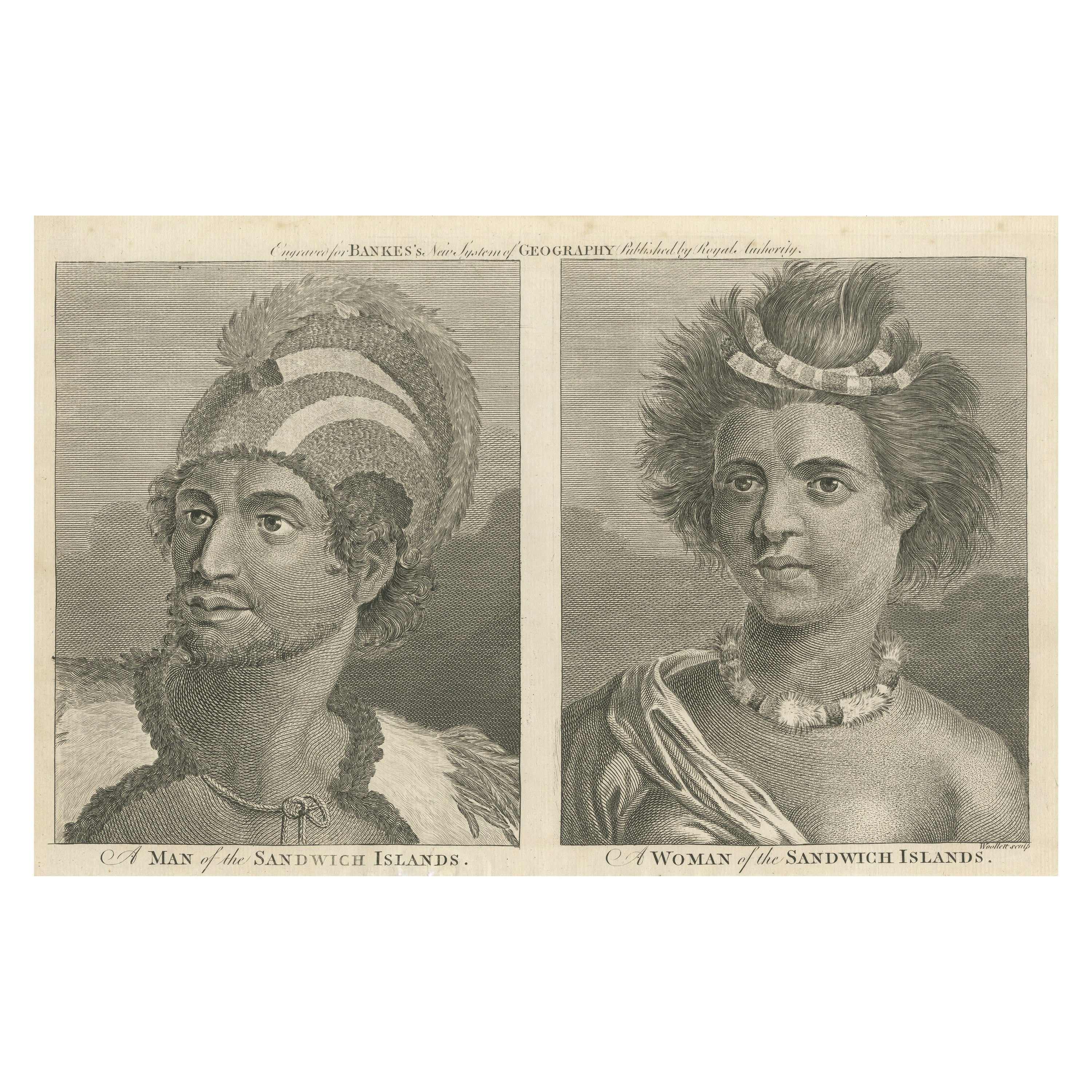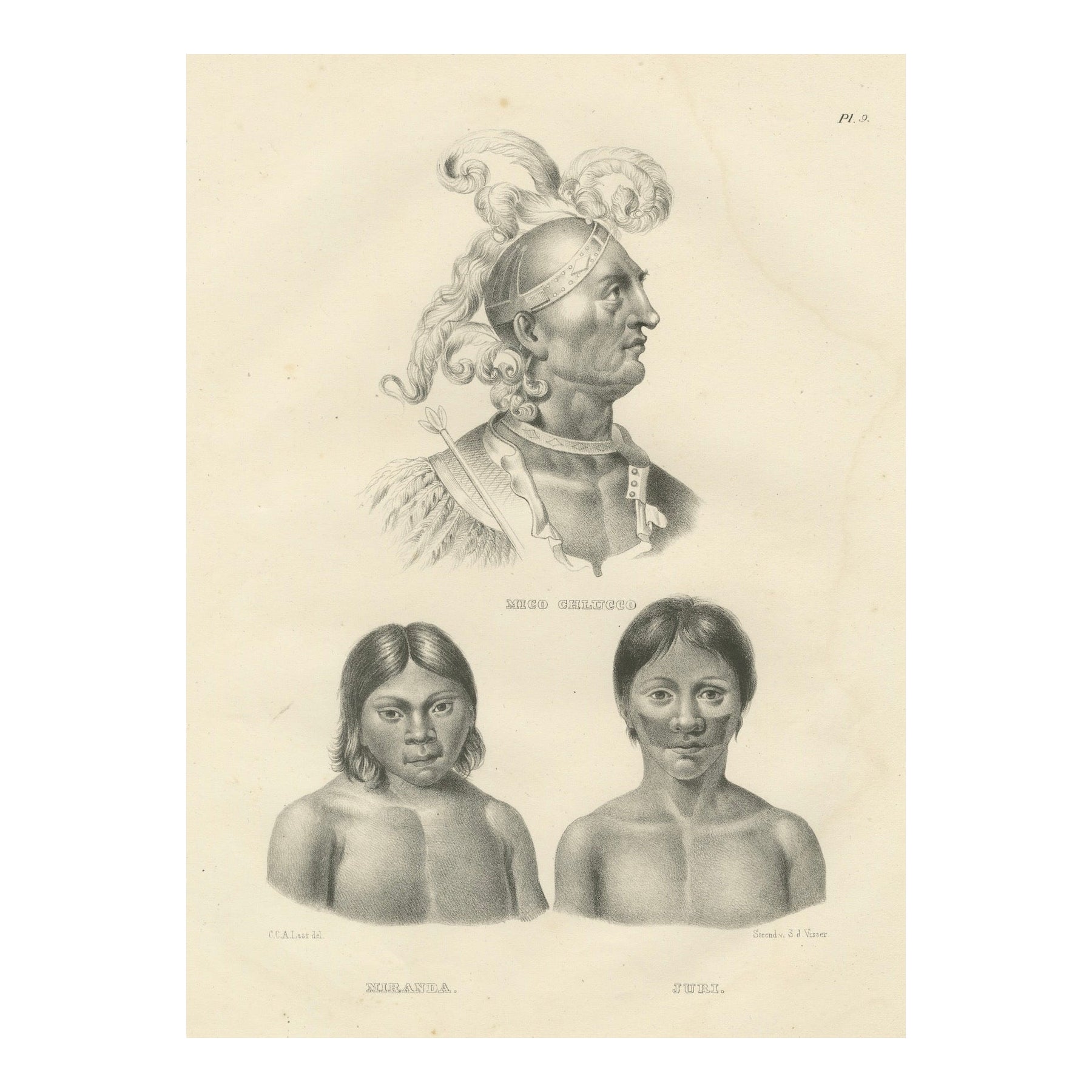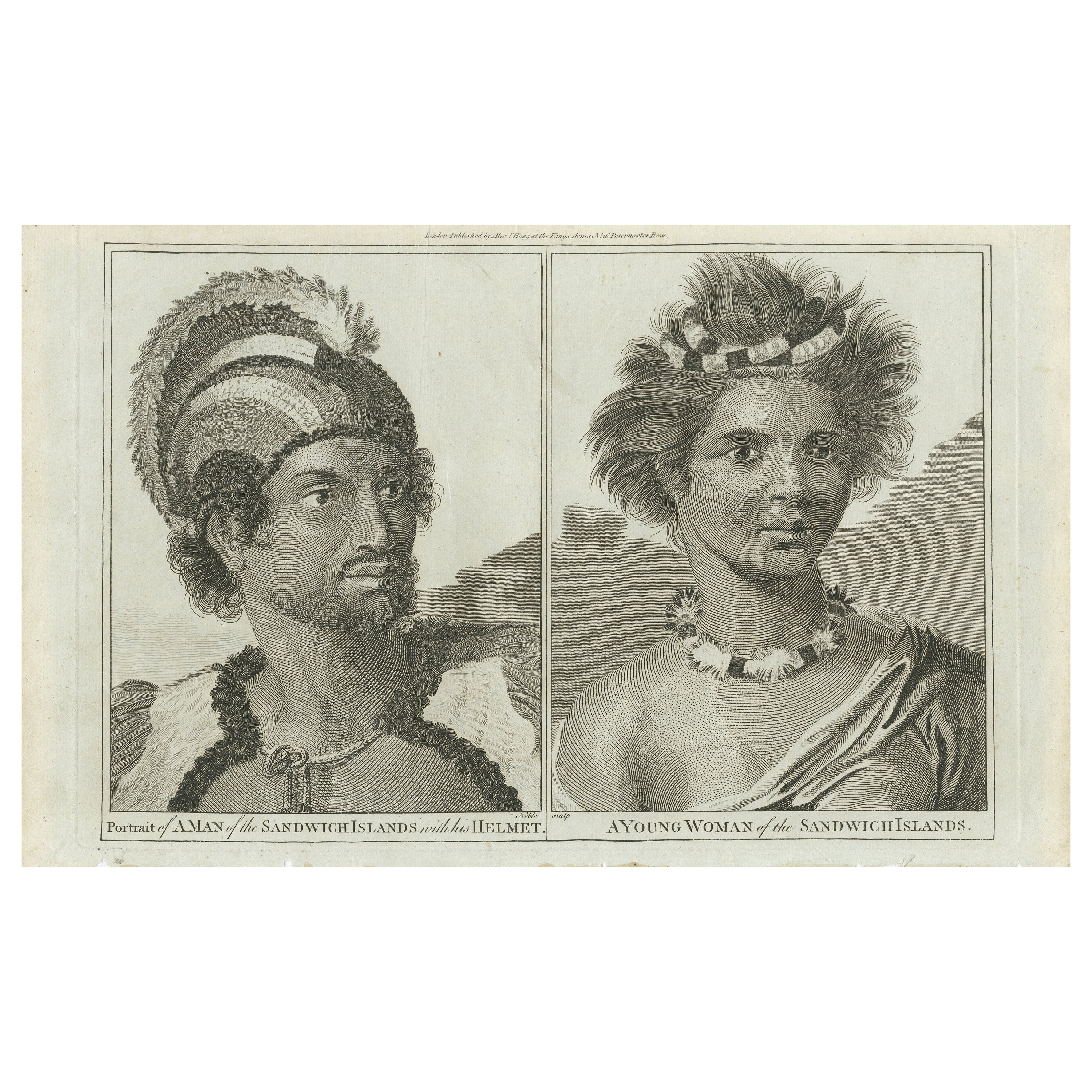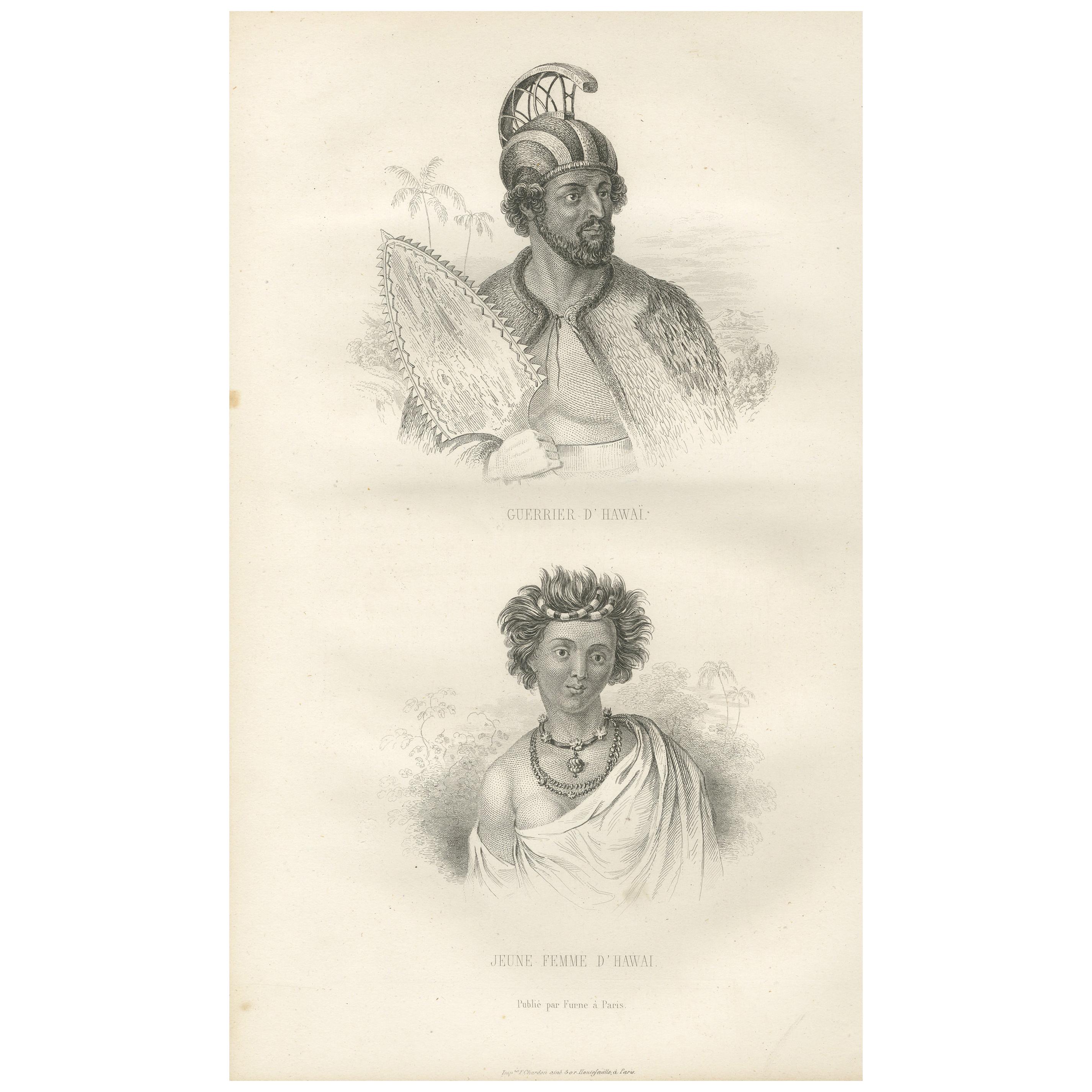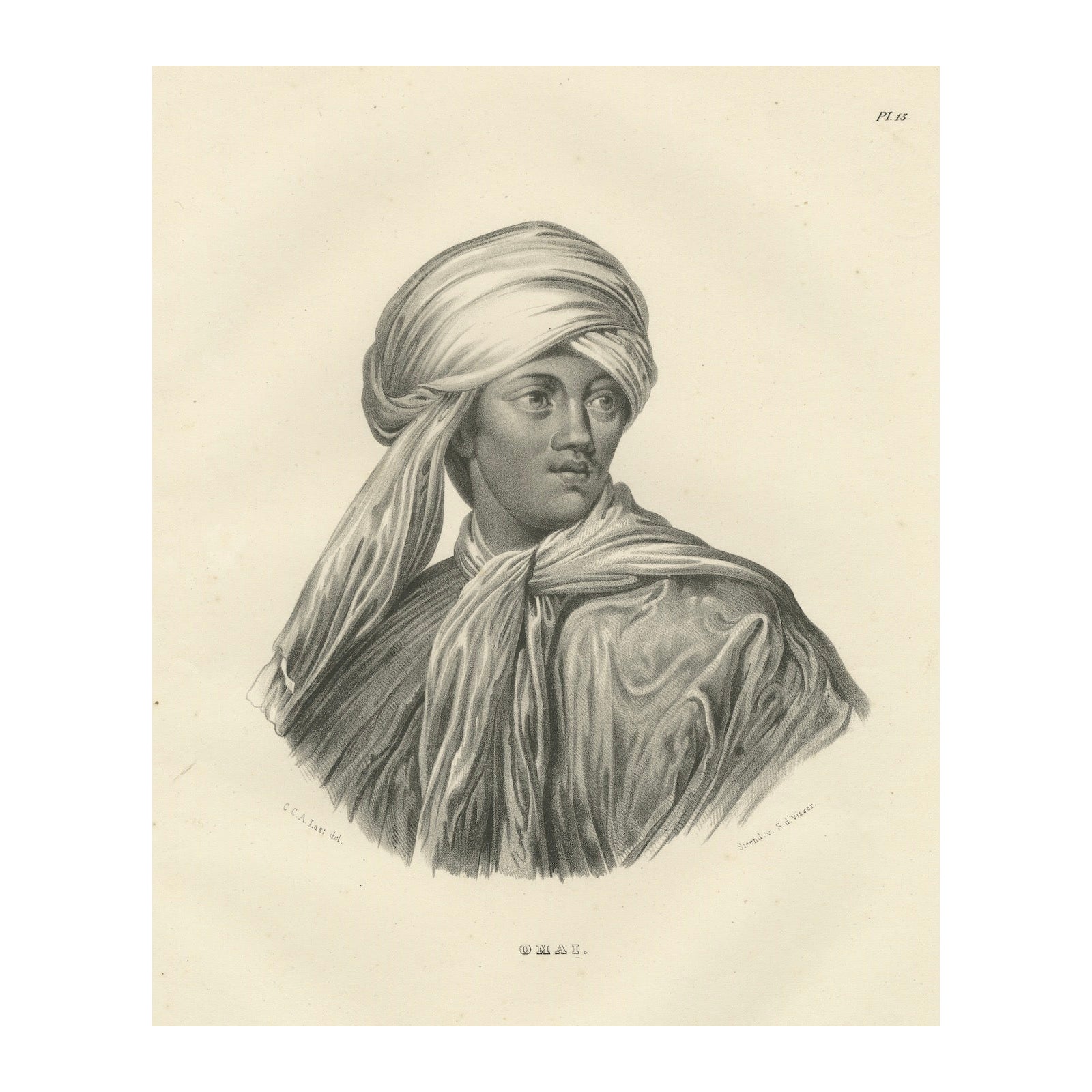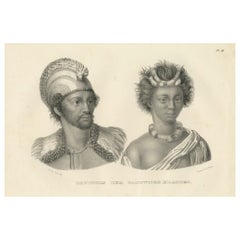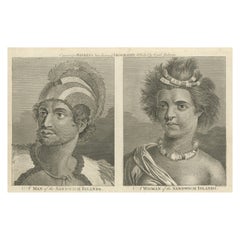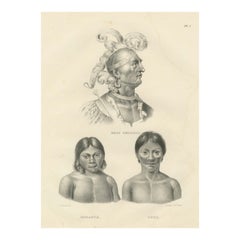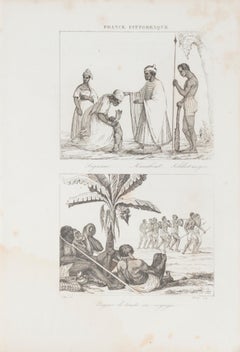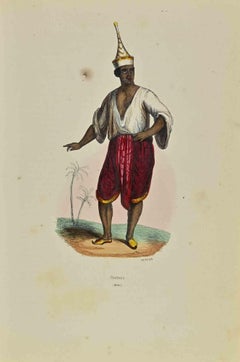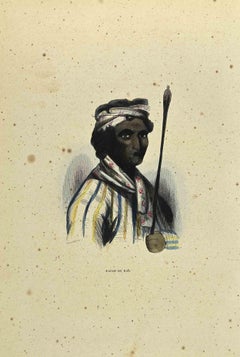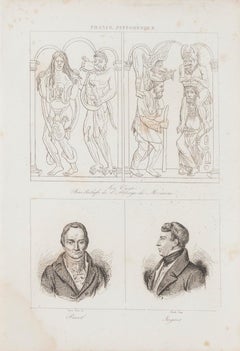Items Similar to Portraits of Tammeamea I of Hawaii and Naba Leba of Solor by Brodtmann, 1836
Want more images or videos?
Request additional images or videos from the seller
1 of 13
Portraits of Tammeamea I of Hawaii and Naba Leba of Solor by Brodtmann, 1836
$389.75
$519.6625% Off
£293.42
£391.2325% Off
€330
€44025% Off
CA$536.90
CA$715.8725% Off
A$601.30
A$801.7325% Off
CHF 313.75
CHF 418.3325% Off
MX$7,344.61
MX$9,792.8125% Off
NOK 3,991.79
NOK 5,322.3825% Off
SEK 3,762.74
SEK 5,016.9825% Off
DKK 2,512
DKK 3,349.3425% Off
About the Item
This lithograph by Karl Joseph Brodtmann depicts two important leaders from the Pacific and Southeast Asia regions: Tammeamea I, King of the Sandwich Islands (now known as Hawaii), and Naba Leba, King of the Island of Solor. These portraits are part of Brodtmann’s ethnographic series documenting notable figures from non-European cultures during the 19th century.
Description:
The lithograph presents two portraits, side by side, of significant monarchs from the Pacific and Southeast Asia, emphasizing their distinct cultural attire and leadership roles.
1. Tammeamea I (left):
Tammeamea I, more commonly known as Kamehameha I, was the first King of the Hawaiian Islands, uniting the islands into one kingdom in the late 18th century. He is depicted here in European-style clothing, which he adopted as part of the increasing contact between Hawaii and the Western world. His clothing includes a buttoned waistcoat and a scarf tied around his neck. His short hair and dignified expression convey the image of a powerful and respected ruler.
2. Naba Leba (right):
Naba Leba is portrayed as the King of Solor, an island in the East Nusa Tenggara region of Indonesia. His attire is notably different from that of Kamehameha, reflecting local traditions. He wears an elaborate headwrap, possibly signifying his royal status, with large, decorative folds that add a sense of grandeur to his appearance. His expression is serious and resolute, capturing the gravity of his position as a leader of his people.
Both portraits emphasize the cultural differences between the two leaders while highlighting their shared status as monarchs. The simple background directs attention to their clothing, facial features, and expressions, providing a clear view of each leader’s distinct cultural identity.
Maker:
Karl Joseph Brodtmann (1787–1862) was a Swiss lithographer known for his detailed illustrations of ethnographic subjects. His works were often included in scientific and anthropological studies, providing European audiences with visual documentation of the peoples and cultures encountered through exploration and colonization. Brodtmann’s portraits of foreign dignitaries were not only valuable for their artistic quality but also as records of global encounters during the age of imperial expansion.
Technique and Style:
Brodtmann employed lithography to create these portraits, a technique that allowed for fine detailing and realistic shading. His style in this piece, as with many of his ethnographic works, is realistic yet romanticized, especially in how the clothing and adornments of the figures are depicted with careful attention to texture and light. Brodtmann's skillful use of shading adds depth and dignity to the portraits, making the figures appear lifelike and expressive.
The contrast between the European-inspired attire of Tammeamea I and the traditional, elaborate headgear of Naba Leba highlights the cultural diversity that Brodtmann sought to document in his ethnographic studies.
Cultural Context:
Kamehameha I, also known as Tammeamea I in this print, was one of the most significant figures in Hawaiian history, credited with uniting the Hawaiian Islands under one kingdom in 1810. His reign marked the beginning of increased contact with European powers, leading to shifts in the cultural and political landscape of Hawaii. By the time of his rule, Kamehameha had adopted certain Western customs, which is reflected in his European-style clothing in this portrait.
Naba Leba, as the King of Solor, would have ruled over an island known for its complex interactions with Dutch colonial powers and local tribal groups. Solor is located in the Indonesian archipelago, and Naba Leba’s attire reflects the traditions of his people, with the intricate headwrap symbolizing his royal status and the cultural uniqueness of his kingdom.
These portraits exemplify the broader European fascination with documenting and understanding the leaders of non-Western cultures during a period of exploration and imperialism. The lithographs would have served as both educational tools and artistic representations of global diversity for a 19th-century European audience.
- Dimensions:Height: 12.8 in (32.5 cm)Width: 10.24 in (26 cm)Depth: 0 in (0.02 mm)
- Materials and Techniques:
- Place of Origin:
- Period:
- Date of Manufacture:1836
- Condition:Condition: good, given age. General age-related toning and/or occasional minor defects from handling. Some stains along the right border, not affecting the image. Please study scan carefully.
- Seller Location:Langweer, NL
- Reference Number:Seller: BG-13176-141stDibs: LU3054341515752
About the Seller
5.0
Recognized Seller
These prestigious sellers are industry leaders and represent the highest echelon for item quality and design.
Platinum Seller
Premium sellers with a 4.7+ rating and 24-hour response times
Established in 2009
1stDibs seller since 2017
2,533 sales on 1stDibs
Typical response time: <1 hour
- ShippingRetrieving quote...Shipping from: Langweer, Netherlands
- Return Policy
Authenticity Guarantee
In the unlikely event there’s an issue with an item’s authenticity, contact us within 1 year for a full refund. DetailsMoney-Back Guarantee
If your item is not as described, is damaged in transit, or does not arrive, contact us within 7 days for a full refund. Details24-Hour Cancellation
You have a 24-hour grace period in which to reconsider your purchase, with no questions asked.Vetted Professional Sellers
Our world-class sellers must adhere to strict standards for service and quality, maintaining the integrity of our listings.Price-Match Guarantee
If you find that a seller listed the same item for a lower price elsewhere, we’ll match it.Trusted Global Delivery
Our best-in-class carrier network provides specialized shipping options worldwide, including custom delivery.More From This Seller
View AllInhabitants of the Sandwich Islands (Hawaii) by Brodtman, 1835
Located in Langweer, NL
This lithograph by Karl Joseph Brodtmann depicts two individuals from the Sandwich Islands, now known as Hawaii. The artwork reflects Brodtmann’s ethnographic interest in documenting...
Category
Antique 1830s Prints
Materials
Paper
$389 Sale Price
25% Off
Portraits of Nobility from the Sandwich Islands (Hawaii), Published circa 1790
Located in Langweer, NL
This original antique engraving is a set of two portraits side by side from "A New, Royal, Authentic and Complete System of Universal Geography, Antient and Modern" published by C. C...
Category
Antique Late 18th Century Prints
Materials
Paper
$302 Sale Price
20% Off
Portraits of Mico Chlucco, Miranda, and Juri by Karl Joseph Brodtmann, 1836
Located in Langweer, NL
This lithograph by Karl Joseph Brodtmann is one of his ethnographic works, featuring three portraits: Mico Chlucco, Miranda, and a Juri individual. The portrayal of these figures ref...
Category
Antique 1830s Prints
Materials
Paper
$415 Sale Price
20% Off
Regalia of the Sandwich Islands: Portraits in Traditional Attire, 1790
Located in Langweer, NL
This engraving, published in London by Alex Hogg at the Kings Arms, No.16 Paternoster Row, features two side-by-side portraits with the labels "Portrait of ...
Category
Antique Late 18th Century Prints
Materials
Paper
$321 Sale Price
20% Off
Antique Print of a Warrior and Young Lady of Hawaii by D'urville (1853)
Located in Langweer, NL
Antique print titled 'Guerrier d'Hawaï - Jeune femme d'Hawai'. Original print of a warrior and young lady of Hawaii. This print originates from volume 1 of 'Voyage Autour du Monde' b...
Category
Antique Mid-19th Century Prints
Materials
Paper
$188 Sale Price
20% Off
Portrait of Omai, a Polynesian Man, by Karl Joseph Brodtmann, 1835
Located in Langweer, NL
This lithograph, titled Omai, by Karl Joseph Brodtmann, is an example of the artist’s ethnographic studies, showcasing a portrait of Omai, a notable figure from Polynesia who visited Europe in the 18th century. This work highlights Brodtmann’s interest in portraying individuals from distant lands, focusing on their unique cultural attire and expressions.
Description:
The portrait represents Omai, a Polynesian man who gained historical significance during the 18th century as one of the first Polynesians to travel to Europe. Omai (also known as Mai) was a central figure in the encounters between Polynesian and European cultures, having been brought to England by Captain James Cook in the 1770s.
- Clothing: Omai is depicted in an elegant wrap of flowing fabric, draped around his shoulders and tied in a loose, elegant fashion. His head is adorned with a large turban, a stylistic interpretation that may have been influenced by European artistic conventions when portraying foreign dignitaries or exotic figures. The fabric's folds and shading add a sense of depth and texture, showcasing Brodtmann’s mastery of lithography.
- Expression: Omai’s expression is poised and dignified, with his gaze directed slightly off to the side. The sense of serenity and composure in his face is typical of the European portrayals of him as an "exotic noble savage," a term that reflects the European fascination with non-Western peoples during the age of exploration.
The lithograph highlights both the individuality of Omai and the cultural significance of his travels to Europe, where he became a symbol of cross-cultural exchange and curiosity during the 18th century.
Maker:
Karl Joseph Brodtmann (1787–1862), the Swiss lithographer, was known for his detailed illustrations of people from various cultures, natural history subjects, and scientific studies. His ethnographic works were part of a broader effort in 19th-century Europe to document the physical and cultural characteristics of peoples encountered through exploration. Brodtmann’s portraits often struck a balance between realism and the romanticized European views of non-Western cultures.
Technique and Style:
Brodtmann created this portrait using lithography, a technique that allowed him to achieve fine details and subtle gradations of light and shadow. His style in this portrait combines realism with the romanticized ideal of the "exotic," particularly in the way Omai is dressed in flowing garments, which may not be entirely representative of traditional Polynesian dress...
Category
Antique 1830s Prints
Materials
Paper
$415 Sale Price
20% Off
You May Also Like
Indigenous Costumes - Original Lithograph - 19th Century
Located in Roma, IT
Indigenous Costumes is an original lithograph realized by an anonymous engraver of the 19th Century.
Printed as part of the series "France Pittoresque", as indicated at the top cent...
Category
19th Century Figurative Prints
Materials
Lithograph
Siamese - Lithograph by Auguste Wahlen - 1844
Located in Roma, IT
Siamese is a lithograph made by Auguste Wahlen in 1844.
Hand colored.
Good condition.
At the center of the artwork is the original title "Siamese".
The work is part of Suite Moeu...
Category
1840s Modern Figurative Prints
Materials
Lithograph
Rajaah de Dao - Lithograph by Auguste Wahlen - 1844
Located in Roma, IT
Rajaah de Dao is a hand colored lithographs realized by Auguste Wahlen in 1844.
Good conditions.
The artwork belongs to the Suite Moeurs, usages et costumes de tous les peuples du ...
Category
1840s Modern Figurative Prints
Materials
Lithograph
Christian Art and Portraits - Original Lithograph - 19th Century
Located in Roma, IT
Christian Art and Portraits is an original lithograph realized by an anonymous engraver of the 19th Century.
Printed in series "France Pittoresque", as indicated at the top center.
Titled in France on the lower center. Included three images on a sheet.
The state of preservation of the artwork is good except for diffused foxing due to timing.
A fascinating piece of art represents portraits on the lower and Christian grotesque art...
Category
19th Century Figurative Prints
Materials
Lithograph
Noukahiwa - Lithograph by Auguste Wahlen - 1844
Located in Roma, IT
Noukahiwa is a hand colored lithographs realized by Auguste Wahlen in 1844.
Good conditions.
The artwork belongsto the Suite Moeurs, usages et costume...
Category
1840s Modern Figurative Prints
Materials
Lithograph
Caribbean Indigenous People / Orinoco, America, mid 19th century lithograph.
Located in Melbourne, Victoria
'Famiglia di Karaibi' / 'Tartarnughe deponenti le uova alle sponde dell' Orenoko''
Italian lithograph, c1841. Originally from 'Galleria universale di tutti i popoli del mondo' by Gi...
Category
Mid-19th Century Naturalistic Figurative Prints
Materials
Lithograph
More Ways To Browse
Dovetail Vinyl Record
Dragon Boat
Egyptian Cat
Embossed Copper Box
English Bow Front Chest
English Headboard
English Iron Bed
Folding Travel Clock
Fornasetti Paper
Four Poster Bed Kings
Francois Pompon
Franz Xavier Bergman
Frem Rojle Chair
French Confit Jar
French Opaline Bottle
French Soda
Garden Rabbit
German Cigarette Case
